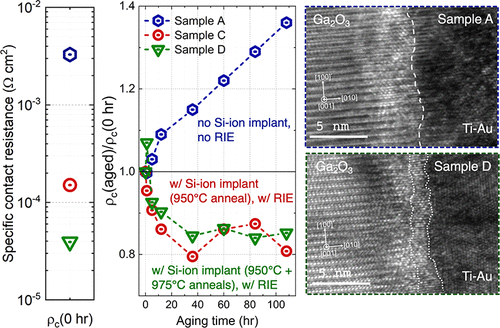当前位置:
X-MOL 学术
›
ACS Appl. Mater. Interfaces
›
论文详情
Our official English website, www.x-mol.net, welcomes your
feedback! (Note: you will need to create a separate account there.)
Accelerated Aging Stability of β-Ga2O3 - Titanium/Gold Ohmic Interfaces.
ACS Applied Materials & Interfaces ( IF 8.3 ) Pub Date : 2020-09-21 , DOI: 10.1021/acsami.0c10598 Ming-Hsun Lee 1 , Rebecca L Peterson 1, 2
ACS Applied Materials & Interfaces ( IF 8.3 ) Pub Date : 2020-09-21 , DOI: 10.1021/acsami.0c10598 Ming-Hsun Lee 1 , Rebecca L Peterson 1, 2
Affiliation

|
Stable ohmic contacts are critical to enable efficient operation of high-voltage electronic devices using ultrawide bandgap semiconductors. Here we perform, for the first time, thermally accelerated aging of Ti/Au ohmic interfaces to (010) β-Ga2O3. We find that a heavily doped semiconductor, doped n-type by Si-ion implantation, treated with reactive ion etch (RIE), results in a low specific contact resistance of ∼10–5 Ω cm2 that is stable upon accelerated thermal aging at 300 °C for 108 h. The low resistance interface is due to thermionic field emission of electrons over an inhomogeneous barrier. Scanning/transmission electron microscopy indicates that the multi-layered structure and elemental distribution across the contact interface, formed during a 1 min 470 °C post-metallization anneal, do not change noticeably over the aging period. A ∼1 nm interfacial layer is observed by high-resolution microscopy at the Ti–TiOx/Ga2O3 interface on all samples exposed to RIE, which may contribute to their excellent stability. In addition, longer-range facet-like interfacial features are observed, which may contribute to the inhomogeneous barrier. In contrast, Ti/Au junctions to moderately doped (010) Ga2O3 made with no RIE treatment exhibit a high contact resistance that increases upon accelerated aging, along with a partially lattice-matched interface. The methods used here to understand the process, structure, and electrical property relationships for Ti/Au contact interfaces to β-Ga2O3 can be applied to assess and tune the stability of a variety of other oxide–semiconductor interfaces.
中文翻译:

β-Ga2O3-钛/金欧姆界面的加速老化稳定性。
稳定的欧姆接触对于使用超宽带隙半导体的高压电子设备的高效运行至关重要。在这里,我们执行,对于第一次,热加速的钛/金的欧姆接口老化至(010)的β-Ga 2 ö 3。我们发现,一个重掺杂的半导体,由Si的离子注入n型掺杂,用反应性离子蚀刻(RIE)处理,导致的低比接触电阻〜10 -5 Ω厘米2在300°C下加速热老化108 h时保持稳定。低电阻界面是由于电子在不均匀势垒上的热电子场发射引起的。扫描/透射电子显微镜表明,在1分钟的470°C金属化后退火过程中形成的跨接触界面的多层结构和元素分布在时效期间不会发生明显变化。通过高分辨率显微镜在Ti–TiO x / Ga 2 O 3处观察到约1 nm的界面层暴露于RIE的所有样品上的界面,可能有助于其出色的稳定性。此外,观察到较远范围的类似小平面的界面特征,这可能是造成不均匀屏障的原因。相比之下,未经RIE处理的中等掺杂(010)Ga 2 O 3的Ti / Au结表现出较高的接触电阻,该接触电阻随着加速老化而增加,并且具有部分晶格匹配的界面。为钛/金接触界面这里用来了解的过程中,结构中的方法,和电性能的关系,以的β-Ga 2 ö 3可以适用于评估和调整的各种其它氧化物-半导体界面的稳定性。
更新日期:2020-10-14
中文翻译:

β-Ga2O3-钛/金欧姆界面的加速老化稳定性。
稳定的欧姆接触对于使用超宽带隙半导体的高压电子设备的高效运行至关重要。在这里,我们执行,对于第一次,热加速的钛/金的欧姆接口老化至(010)的β-Ga 2 ö 3。我们发现,一个重掺杂的半导体,由Si的离子注入n型掺杂,用反应性离子蚀刻(RIE)处理,导致的低比接触电阻〜10 -5 Ω厘米2在300°C下加速热老化108 h时保持稳定。低电阻界面是由于电子在不均匀势垒上的热电子场发射引起的。扫描/透射电子显微镜表明,在1分钟的470°C金属化后退火过程中形成的跨接触界面的多层结构和元素分布在时效期间不会发生明显变化。通过高分辨率显微镜在Ti–TiO x / Ga 2 O 3处观察到约1 nm的界面层暴露于RIE的所有样品上的界面,可能有助于其出色的稳定性。此外,观察到较远范围的类似小平面的界面特征,这可能是造成不均匀屏障的原因。相比之下,未经RIE处理的中等掺杂(010)Ga 2 O 3的Ti / Au结表现出较高的接触电阻,该接触电阻随着加速老化而增加,并且具有部分晶格匹配的界面。为钛/金接触界面这里用来了解的过程中,结构中的方法,和电性能的关系,以的β-Ga 2 ö 3可以适用于评估和调整的各种其它氧化物-半导体界面的稳定性。

















































 京公网安备 11010802027423号
京公网安备 11010802027423号